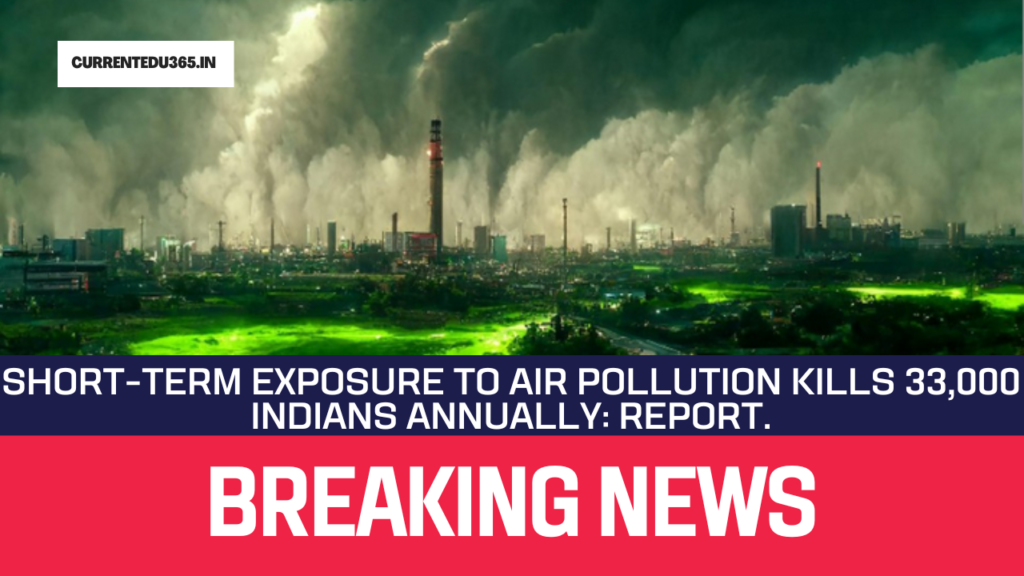NEW DELHI – On 2 November 2023, extreme air pollution caught Delhi off-guard. It shut down schools and led to flight cancellations, curbs on construction and other emergency responses.Short-Term Exposure to Air
That every little increase in air pollution increases the risk of death has been well-establish for some years. But till now the effect of short-term air pollution on mortality has remained largely undocumented in detail in India. Where most of the world’s most polluted cities are located.

Read More:-Jaishankar China’s Wang Yi likely to meet in Astana tomorrow’s.
In a new, peer-reviewed study published in the Lancet on Thursday (4 July). Rsearchers found that 7.2% (or approximately 33,000) of all deaths. Each year across 10 cities could be link to short-term PM 2.5 exposure higher than the World Health Organization. (WHO) guideline of 15 microgram/cubic metre. PM 2.5 is a highly toxic ultra-fine particulate matter with a diameter of 2.5 microns, which is far thinner than a strand of human hair.Short-Term Exposure to Air
New Delhi: Nearly 33,000 deaths in 10 cities in India every year can be attribute to air pollution levels. That are below India’s national clean air threshold. The report has been publish in Lancet Planetary Health.
India’s clean air norms are presently well above the World Health Organizations guideline of 15 microgram in every cubic meter of air. The report makes the point that India must drastically reduce. Its clean air norms to at least match WHO guidelines to protect citizens from the dangers of polluted air.
Even levels of air pollution below current Indian air quality standards lead to increased daily mortality rates in the country, the study found.
“Across 10 cities in the country – Ahmedabad, Bengaluru, Chennai, Delhi, Hyderabad, Kolkata, Mumbai, Pune, Shimla, and Varanasi, around 33,000 deaths per year can be attribute to air pollution levels that are above the WHO guidelines.
A recent study published in Lancet Planetary Health states that air pollution levels below India’s national clean air threshold are responsible for approximately 33,000 deaths annually across ten cities in the country.
The research indicates that even sub-standard levels of air pollution contribute to increased daily mortality rates.Short-Term Exposure to Air
On average, 7.2 per cent of all daily deaths in 10 of the largest and most polluted cities in India. Including Delhi, Bengaluru and Mumbai, were link to PM2.5 levels higher than World Health Organization (WHO) guidelines for safe exposure, according to a study publish in The Lancet Planetary Health journal.Short-Term Exposure to Air
Delhi was found to have the largest fraction of daily and yearly deaths attributable to PM2.5 air pollution, caused by particles sized 2.5 micrometers.
The death toll from India’s air pollution is elevate even in cities previously thought to have relatively clean air. Underscoring how the problem extends beyond megacities such as Delhi. According to a study in the journal The Lancet Planetary Health.
Thursday’s report shed new light on the pervasive nature of the country’s air-quality crisis. It found that a significant share of the 33,000 yearly deaths attributable to air pollution in 10 cities examine was record in coastal centers like Bangalore, Chennai, Kolkata and Mumbai, where air quality is consider to be moderate.
The significant effects we are observing even below the Indian air quality limits are alarming,” said Bhargav Krishna. Fellow at the Sustainable Futures Collaborative and the study’s lead author, “suggesting. That perhaps we have set our standards higher than they should be.”
Read More:-Sudha Murty calls for cervical cancer vax, Domestic Tourism In Maiden Rajya Sabha speech.




Pingback: Champai Soren quits as Jharkhand CM to make way for Hemant Soren’s return. - CurrentEdu365
Pingback: Supreme Court Bench Led by CJI DY Chandrachud To Hear NEET-UG Petitions on July 8. - CurrentEdu365